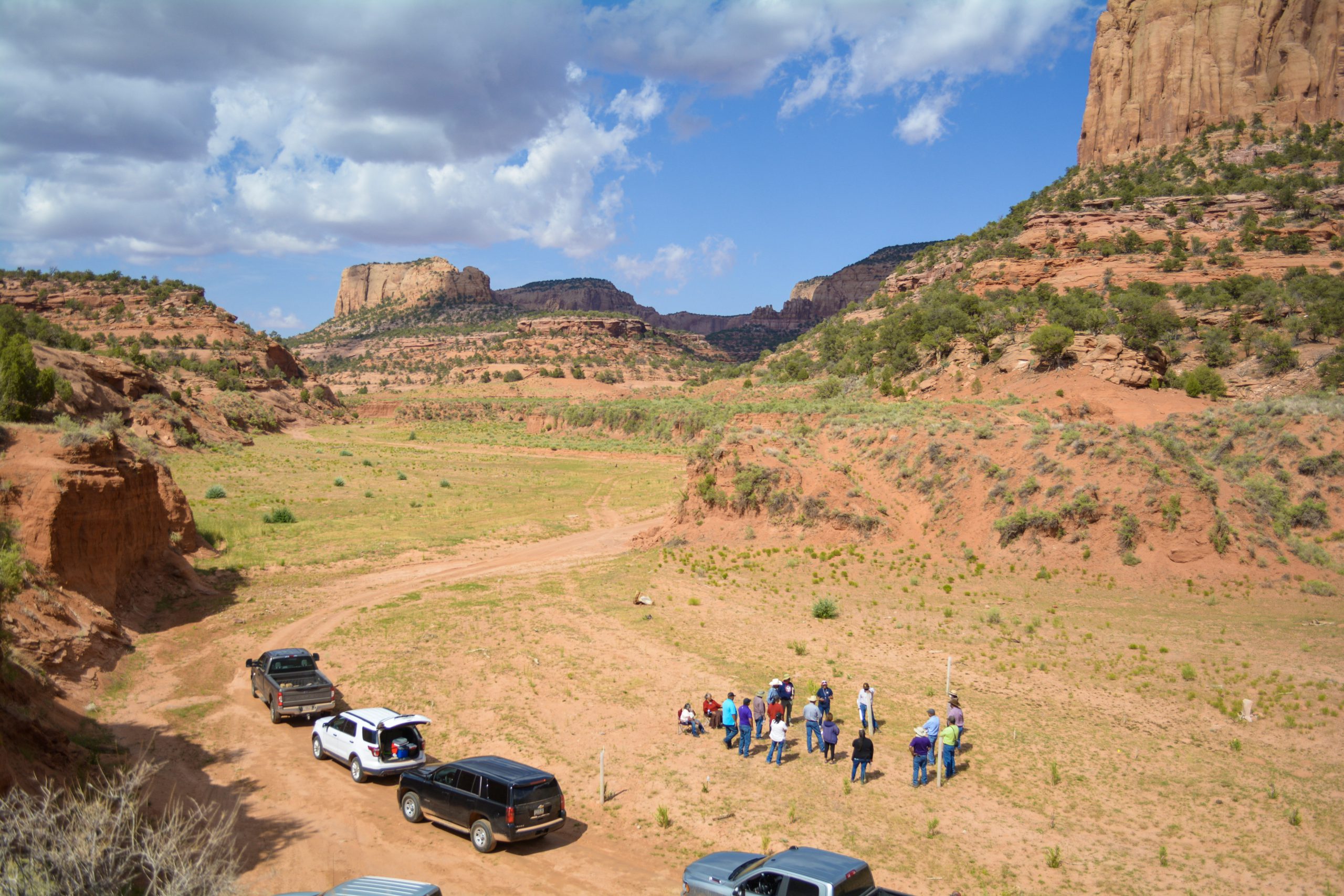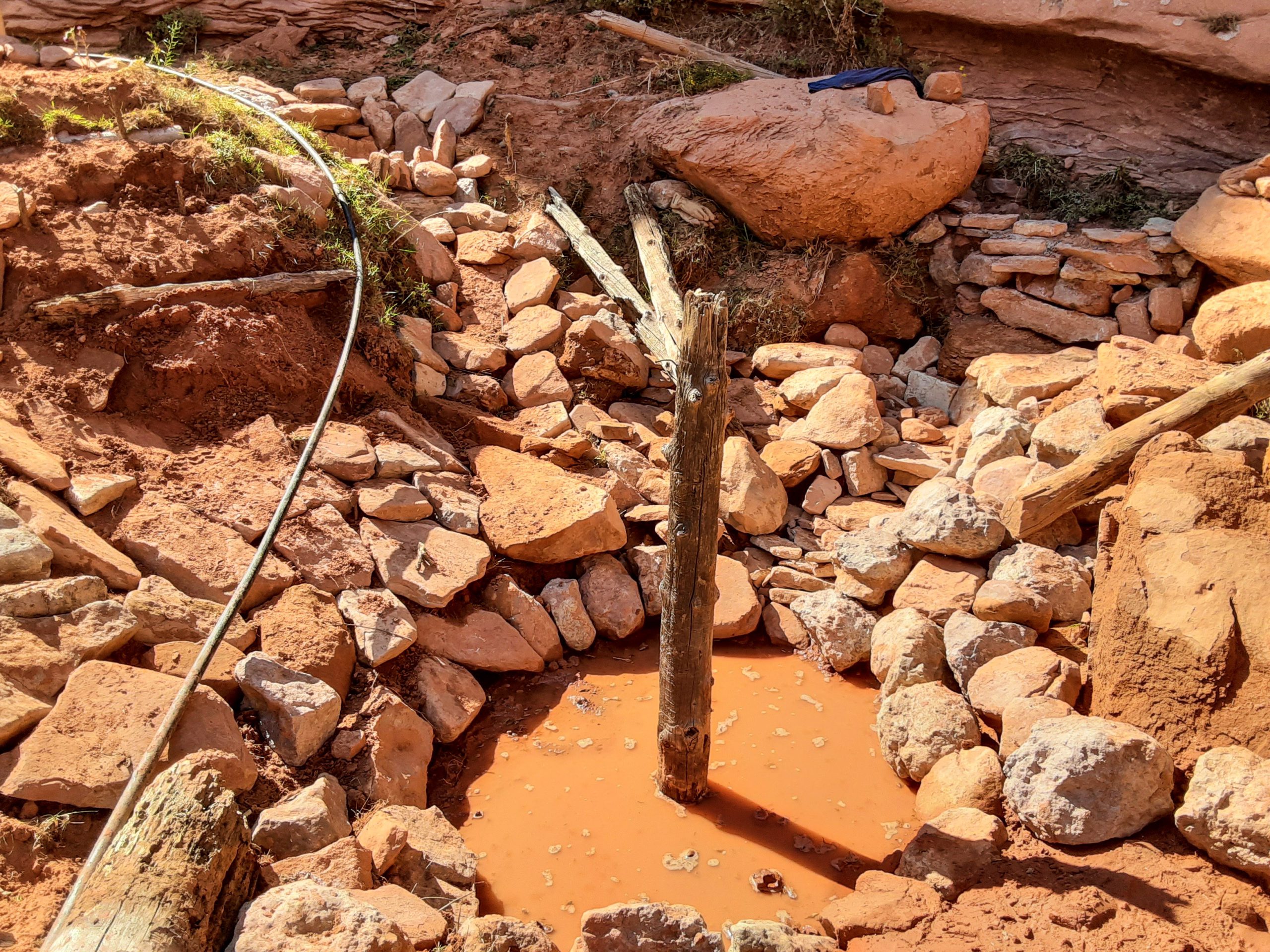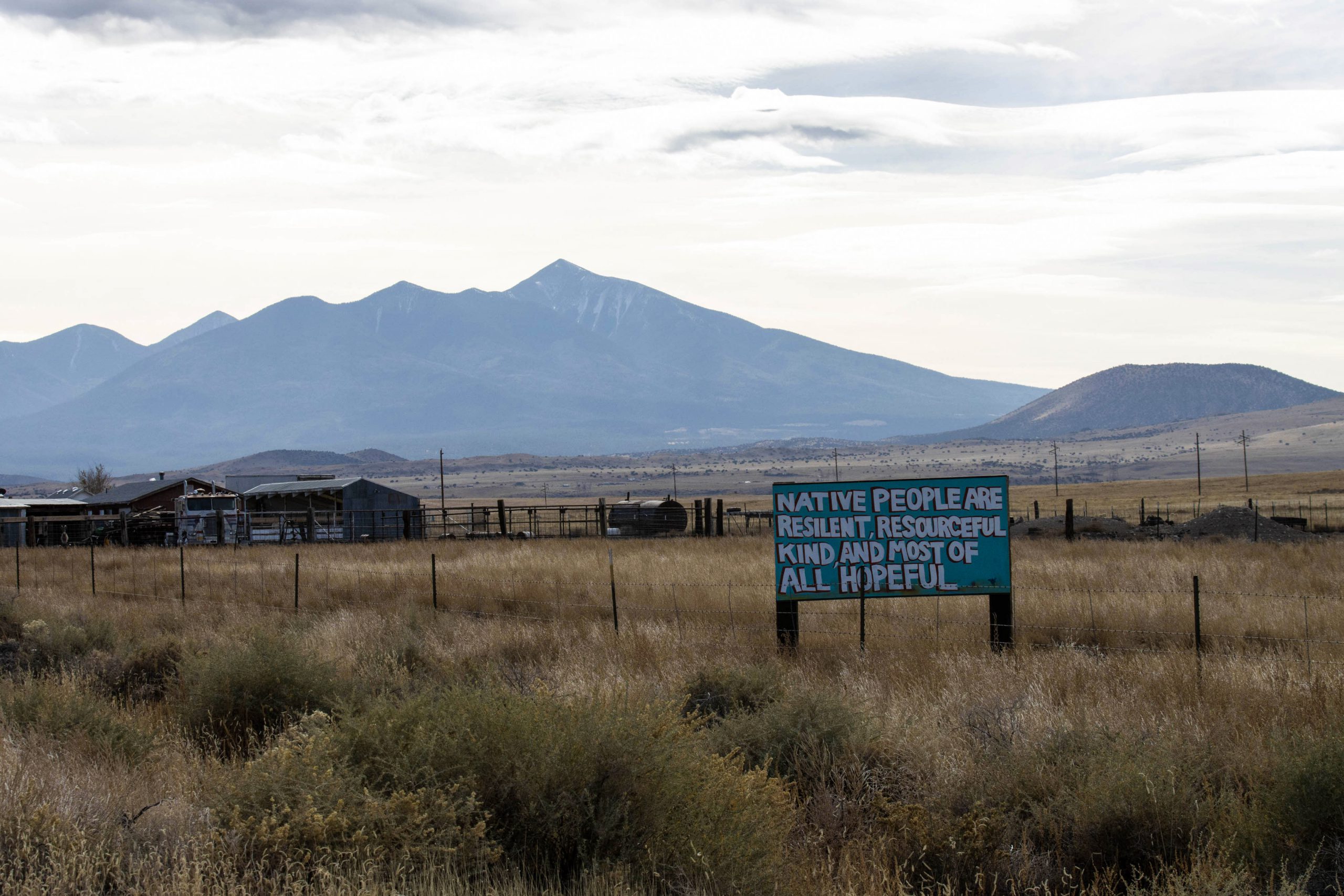Indianz.Com > News > Cronkite News: Navajo Nation works to address climate change

Time, tradition and trust: The Navajo Nation takes on climate change
Tuesday, April 12, 2022
Cronkite News
PHOENIX, Arizona — For many years, Tsegi Canyon on the Navajo Nation struggled: Its dry walls and streambanks were eroding, exposing crumbling red soil to the desert sky. Its springs were drying up; native plants were few and far between on the canyon floor, often replaced by invasive weeds.
This land, beautiful and remote, was tired, said Nicholas Chischilly, a wildlife technician with the Navajo Nation Climate Change Program, which operates under the tribe’s Department of Fish and Wildlife.
There’s a lot of history there, he said, and secluded Tsegi Canyon, – 13 miles from Kayenta near the Navajo National Monument – is one of the few places on the reservation where water flows year round.
Chischilly recalls hearing elders tell stories about days long past, when knee-high grass kept sheep and cattle healthy and fat across the vast nation.
But in recent years, he said, entering Tsegi Canyon was like going into another world.
“The stream banks were collapsing. Plant life was barely holding on. The families who live there told us about thousand-pound sections of cliff that fell off,” Chischilly said. “We’ve also heard that the canyon has been eroding so fast that a lot of people thought that if their elders were to come back to the area, they would not recognize it.”
But in a place where “the land makes the people,” that is changing despite a host of challenges, from language barriers to decades of broken promises.
Starting in 2018, the exhausted canyon was finally allowed to rest, and a pilot project by Fred Phillips Consulting started restoration work. Fences were erected and livestock relocated. Native plants were reintroduced to restore the riparian area.
Two years later, Fred Phillips Consulting and volunteers from the Navajo Nation Climate Change Program put up more fencing, and they built Zuni bowls and employed other water management techniques to redirect and preserve streamflow.

Global conversations happening locally
The Navajo Nation, like many communities across the globe, is having conversations about how to adapt to climate change and how to stave off some of the worst effects of extreme conditions.
These conversations are in line with the latest Intergovernmental Panel on Climate Change assessment, which confirms that more extreme weather events are ahead if greenhouse gas emissions aren’t drastically reduced.
From 2010 to 2019, average annual greenhouse gas emissions were at their highest level in human history, according to the IPCC report.
Limiting temperature rise to 2.7 degree Fahrenheit is nearly impossible, report authors say, unless greenhouse gas emissions peak before 2025 and emissions are cut by 43% by 2030.
If that isn’t achieved, then it will be impossible to go back, said Kathy Jacobs, who directs the Center for Climate Adaptation Science and Solutions at University of Arizona. Cronkite News talked with Jacobs in February after the first report came out.
The IPCC assessment includes solutions and adaptation strategies for climate change. But it also encourages the incorporation of Indigenous knowledge and lived experiences into the efforts.
“But if you’re trying to bring the knowledge of the ancestors and the people who have known this land to bear on this topic, while the species that they know may be leaving, that’s a pretty big challenge,” Jacobs said.

The toll of climate change
Indigenous people across the globe are disproportionately impacted by the effects of climate change, despite contributing very little to the emissions that cause some of its most extreme effects, Jacobs said.
The effects of climate change are being felt in different ways across the 27,673 square mile Navajo Nation, which includes 110 chapters – each one unique, Chischilly said.
“A lot of people are becoming aware of climate change,” he said, “but it’s so unique here on the reservation because every community has their different issues. In one area, it would be totally devastated by drought and overgrazing. Other areas in the higher elevations are experiencing trees dying off.”
The Navajo Nation released its first climate adaptation plan in 2018, after long talks with elders and community members to identify such priorities as addressing drought, pollution and overgrazing.
For the past several years, Howard said, the Navajo Nation Climate Change Program has tried to get on the same page as members about climate change, especially elders and some of the older generations, by bringing awareness about the issue. This process is complicated, especially because many elders only speak Navajo.
“The concept of climate change, ecological restoration and so forth is hard to communicate, especially when there’s a language barrier,” Howard said. “Many of the concepts, like carbon footprints and greenhouse gasses, are not easily translated into the Dinè Navajo language.”
Trust building is at the core of much of the climate program’s work.
“A lot of these new techniques, even though they might be relatively low technology and low cost, like just simple erosion control, require buy-in from communities and the acceptance that these techniques work before we can start any implementation at all,” Chischilly said.
But despite the sensitivity and challenges, progress is being made.
Drought tour leads to progress
In 2019, Chischilly and Howard began visiting several chapters across the reservation to discuss and educate community members about the impacts of climate change.
They had reached a handful before the COVID-19 pandemic set in, and the Navajo Nation closed. Now, Chischilly said, the tribe is taking its first steps toward restoration projects, based on feedback from a reservation tour last July by Navajo resource and development officials to gauge the effects of drought and overgrazing.
One of the stops was Tsegi Canyon, where the positive impacts of ecological restoration techniques were demonstrated.
“We wanted to educate people about climate change with this tour, but we also wanted to show people tools they can use to adapt,” Chischilly said.
But he and Howard said uneasiness remains between the calls from scientists to take immediate action on climate change and the historical trauma Native people have suffered when the government dictates how their lands should be used.
“Not just the Navajo Nation, but native people in general across the United States, we all suffer from transgenerational trauma,” Howard said. “In the 1930s, the Bureau of Indian Affairs forcibly removed livestock from our nation. This really impacted our people because that was our way of life. Our elders and our people loved their herds of sheep, cows and horses.”
This history, Howard said, makes it hard to bring up the Western scientific concept of a “point of no return” requiring immediate action.
“Many people still carry that experience and trauma with them,” he said.
Time, tradition and trust
But Chischilly said the idea of a “point of no return” is making some Navajos more aware of climate change.
“It’s difficult to communicate that concept when our lifestyles are at our own pace,” Chischilly said. “We have a slower way on the reservation because it’s hard to get that immediate buy-in and also immediate implementation, because sometimes that’s just not how it works. A lot of people need that trust first.”
“When there’s no trust and you try to come into a community right off the bat, it’s like, ‘I don’t really know you, I don’t trust you yet. Explain this to me.’”
When it comes to making decisions about the environment, Chischilly and Howard said choices around climate change on the Navajo Nation can be extremely personal, especially for elders.
“This involves the heart, our lifestyles and the way we choose to live,” Chischilly said. “The land makes the people. That’s where we get our identity from as a people. It’s born through the environment we live in, the Southwest. So it’s not only scientific in talking about the land, it’s also talking about emotion, spirituality and faith.”
Howard noted a spiritual aspect to addressing climate change. Although it’s considered controversial by some Navajo people, he said reintroducing songs, prayers and rituals to reconnect with the Earth, especially among younger generations, will play a large part in addressing climate change in the future.
“Mother Earth is sick and she needs healing,” Howard said. “And that healing comes from all these prayers and songs, in addition to our resilience. This word always comes up with Indigenous people who heal from these issues, because climate issues are a sickness. Everything is interconnected. We must treat that healing process as a duty. Resiliency is who we are. But we also need to reclaim it.”
Despite the challenges and changes ahead, Howard and Chischilly said they have faith that the Navajo Nation will get through this alongside Indigenous people across the globe through resilience, reconciliation and self-determination.
“A lot of sacrifices will have to be made from ourselves and from our people, but we will be able to address these issues,” Chischilly said. “We will find ways to bring our land back in as a self-sustainable ecological system on the Navajo Nation.”
For more stories from Cronkite News, visit cronkitenews.azpbs.org.
Note: This story originally appeared on Cronkite News. It is published via a Creative Commons license. Cronkite News is produced by the Walter Cronkite School of Journalism and Mass Communication at Arizona State University.
Search
Filed Under
Tags
More Headlines
President Trump’s ‘love’ for Lumbee Tribe only goes so far in fight for federal recognition
Native America Calling: Native American representation in television news
Native America Calling: Native youth building the foundation for future leadership
Republicans forced to defend record on Indian issues at start of new Congress
Native America Calling: How it started, how it’s going with Donald Trump
President Trump targets Indian education in first round of executive actions
House Committee on Natural Resources convenes for first meeting
Alaska Beacon: Republicans oppose President Trump on Native name change
Native America Calling: Is the Antiquities Act an antique?
Austin Kaus: The world is less funny with the passing of ‘The Indian’ Terry Ree
Peoples World: Indigenous Peoples Coalition secures name change for historic park
Arizona Mirror: Lawsuit filed over sober living home scam targeting Native people
Cronkite News: ‘Navajos 4 Trump’ traveled to nation’s capital for inaugural parade
NAFOA: 5 Things You Need to Know this Week (January 21, 2025)
Native America Calling: ‘It’s finally over – I’m going home’
More Headlines
Native America Calling: Native American representation in television news
Native America Calling: Native youth building the foundation for future leadership
Republicans forced to defend record on Indian issues at start of new Congress
Native America Calling: How it started, how it’s going with Donald Trump
President Trump targets Indian education in first round of executive actions
House Committee on Natural Resources convenes for first meeting
Alaska Beacon: Republicans oppose President Trump on Native name change
Native America Calling: Is the Antiquities Act an antique?
Austin Kaus: The world is less funny with the passing of ‘The Indian’ Terry Ree
Peoples World: Indigenous Peoples Coalition secures name change for historic park
Arizona Mirror: Lawsuit filed over sober living home scam targeting Native people
Cronkite News: ‘Navajos 4 Trump’ traveled to nation’s capital for inaugural parade
NAFOA: 5 Things You Need to Know this Week (January 21, 2025)
Native America Calling: ‘It’s finally over – I’m going home’
More Headlines